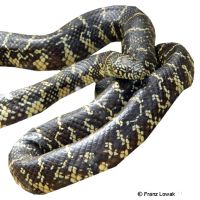Florida Kingsnake (Lampropeltis getula floridana)
| Florida Kingsnake Lampropeltis getula floridana | |
|---|---|
| Name | Florida Kingsnake |
| Name Lat. | Lampropeltis getula floridana |
| Synonym | Lampropeltis getula |
| Family | Colubrids |
| Family lat. | Colubridae |
| Order | Scaled Reptiles |
| Order lat. | Squamata |
| Origin | Florida |
| Habitat | Humid savanna |
| Diet | Small mammals |
| Humidity | 50-70 % |
| Behavior | Peaceful |
| Keeping | Individual |
| Care Level | Moderate |
| Reproduction | Oviparous |
| Housing | Semi-humid terrarium |
| Life Span | 10-15 years |
| Protection | EU-DVO 2022/1203 Invasive alien species |
| Metric Units | |
| Size | 90-120 cm |
| Temperature | 24-28 °C |
| Temperature Local | 30-32 °C |
| Housing Size | 130 x 70 x 70 cm |
| US Units | |
| Size | 35"-47" |
| Temperature | 75-82 °F |
| Temperature Local | 86-90 °F |
| Housing Size | 50" x 30" x 30" |
Distribution and habitat
The predominantly diurnal, ground-dwelling Florida king snakes are found exclusively (endemically) in southern Florida (USA), where they live in wet savannas and swamps, but also in grasslands, forests and sugarcane plantations.
Maintenance
Minimum dimensions for the terrarium, according to the size and number of animals:
| 1-2 animals | 1KL x 0,5KL x 0,5KL (L x W x H) |
Body length (KL) is measured on the largest animal. For each additional animal the floor space should be increased by 20%. A terrarium of e.g. L 130 x W 70 x H 70 cm is recommended, which should be placed in a quiet and vibration-free place.
They need a terrarium structured with roots, stones and cork tubes (hiding places and visual protection) with a graveable substrate, e.g. of sand-humus mixture with peat and foliage, as well as an easy to clean water basin as drinking vessel. To ensure constant humidity, a small portion of the substrate must always be kept slightly moist, for which sheets of sphagnum moss are well suited. Once a day, preferably in the evening, the inside of the terrarium should be finely sprayed with water. A rain or mist system is ideal
| Temp. day: 24-28 °C | Temp. night: 18-22 °C | Temp. local: up to 32 °C | Humidity: 50-70 |
Thermostatically controlled floor heating is recommended. Lighting duration must be 12-14 hrs depending on the season. Daylight fluorescent tubes supplemented with UV lamps are ideal.
Diet
The food supply consists of live rodents (e.g. mice, rats) and nestlings according to their size. After acclimatization, it is often possible to switch to dead food (commercially available frozen food). Juveniles should be offered food every 3-5 days, adults every 7-14 days, with occasional periods of fasting (e.g., skipping a feeding). If the snake is disturbed after feeding, this may result in vomiting of the prey. It is better to offer several small feeders, rather than one large one. If it does not eat for a long period of time, both the timing and the food should be varied. It is important to fortify the food animals with vitamins and minerals. Since the snake could be injured by live rodents, it should not be left unattended with them.
Reproduction and breeding
Probing by the veterinarian is the only reliable method of sex determination.
A resting period is recommended for successful reproduction. The female lays her eggs (3-30 eggs) in the moist substrate about 5 cm deep and does not perform brood care. The incubation period is 60-70 days at a temperature of 28 °C. The young are 12-20 cm in size and can be fed with nest young mice.
Important
They come in different color varieties and are usually docile, but can bite hard. Socialization is not recommended as they will eat conspecifics and other snakes, including venomous ones. They require a basking spot warmed by radiators. When threatened, they vibrate their tails and emit strong-smelling feces.
A resting period of 3-4 months at a temperature of 8-12 °C accompanied by a feeding break is recommended.
Always have snake hooks and protective gloves ready when handling.The terrarium must have good ventilation without drafts and meet the species-specific needs. Measuring devices such as thermometers, hygrometers, etc. are necessary. The lighting has to correspond to the species-specific day-night rhythm and has to be placed in such a way that the animals cannot injure themselves. The terrarium should be locked in such a way that neither unauthorized persons can open it nor the animals can escape. Contamination must be removed regularly
Further literature can be found in your pet store.
References
Text: Christian Sänger; Image: Franz Lowak
Source: BMELV (1997): Tierschutzgutachten - Mindestanforderungen an die Haltung von Reptilien; ENGELMANN (2006): Zootierhaltung - Tiere in menschlicher Obhut: Reptilien und Amphibien, Harri Deutsch Verlag
- Gemäß § 21 Abs. 5 Tierschutzgesetz idgF
